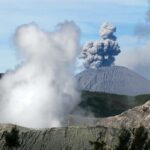This article provides 18 free Science Lesson Units for students in grades 6–8. Learning science and performing science lesson experiments and activities is beneficial for middle school students in several ways:
- Hands-on Learning: Science experiments and activities provide a hands-on learning experience, allowing students to see the practical application of scientific concepts and principles.
- Critical Thinking and Problem-Solving: Engaging in experiments and activities helps students develop critical thinking and problem-solving skills as they analyze data, draw conclusions, and solve real-world problems.
- Interest and Engagement: Science experiments can spark curiosity and interest in the subject, making learning more engaging and enjoyable for students.
- Understanding Complex Topics: By conducting experiments, students can better understand complex scientific topics and principles, laying a strong foundation for future learning in science and related fields.
- Preparation for the Future: Engaging in science activities and experiments can help students develop important skills that are valuable for future careers in science, technology, engineering, and math (STEM).
Overall, learning science through experiments and activities not only helps students understand the natural world but also fosters important skills and attitudes that are beneficial for their academic and professional development.
Quick Links to Science Lesson Units in this Article:
- Scientific Thinking Lesson Units
- Preparing a Scientific Investigation Lesson Units
- Measurement Lesson Units
- Life Science Lesson Units
- Energy Lesson Units
- Chemistry Concepts Lesson Units
All documents in this article © 2023 Strategic Education Research Partnership | This work is licensed under an Attribution-NonCommercial-NoDerivs 4.0 International License (CC BY-NC-ND 4.0 DEED): https://creativecommons.org/licenses/by-nc-nd/4.0/. No changes have been made to these documents. SERP also provides these science lesson units as online modules, along with additional content, if that method is preferred.
Science Lesson Units for Grades 6-8 from SERP
Scientific Thinking Lesson Units
UNIT 6.1: Did you notice that?
Students will gain an understanding of the distinction between observations and inferences, as well as how to make quantitative and qualitative observations. In a lab setting, students will put their observational and inferential skills to the test in a practical setting.
UNIT 6.2: Why do we make models?
Students will investigate the rationale behind the employing of models by scientists and other professions in this course. Before deciding to construct a dam, students make a watershed model using a landform map and are invited to document their steps in writing.
UNIT 6.3: Can you really claim that?
This course presents scientific theories that have supporting data and evidence. By doing an experiment on skateboarding, students learn to critically evaluate claims. Before drawing any conclusions, students run a number of experiments and plot the data graphically.
Preparing a Scientific Investigation Lesson Units
UNIT 6.4: Is that really a fair test?
Students will discover the scientific definition of “fair” and the steps to take to ensure that their tests are objective. The significance of objective measurement, the use of numerous trials, and the concept of variables and their control are all covered in this unit.
UNIT 6.5: How do we test that idea?
Students will study the steps to formulate a scientific hypothesis, prepare and carry out an experiment to test it, and report their findings.
UNIT 6.6: Ready to conduct your own investigation?
As part of a scientific investigation, students look into what is needed for an experiment. Each student is responsible for developing a testable question, designing an experiment, carrying it out methodically, collecting data, and presenting their results to the class. Along with giving presentations, students are also expected to interact with other groups by asking questions and providing feedback.
Measurement Lesson Units
UNIT 7.1: So what exactly is a unit?
This unit exposes students to the scientific language of measurement and helps them learn more about key terms they may have misunderstood. Students are also taught the importance of exact terminology when writing lab reports or documenting data. Each student in the class develops and presents their own unique method of measuring.
UNIT 7.2: Does the metric system measure up?
Students return to working with the metric system, with a focus on conversions, prefixes, and abbreviations. Students will watch an animation before beginning a volume lab, after which they will complete a writing assignment.
UNIT 7.3: The Power of Per
Students will learn about rate and ratio, which expands on their knowledge of measuring. The unit ends with a writing assignment after students have learned how to compute ratios and rates via a series of lab exercises.
Life Science Lesson Units
UNIT 7.4 Populations in Balance
This unit introduces ecological concepts, including the study of ecosystems and the processes of disturbance and recovery, whether caused by humans or natural disasters. In a mock town hall meeting, students express their diverse views on a proposed community rule.
UNIT 7.5: Traits and Heredity
The unit teaches classical genetics, covering the fundamental principles of inheritance. It explores Gregor Mendel’s work on inheritance patterns and applies the concepts of dominant and recessive characteristics. Additionally, it prompts students to write about whether prospective parents should be aware of being carriers of certain genetic disorders after learning about these conditions.
UNIT 7.6: Thinking About Natural Selection
Natural selection and adaptability are covered in this unit. Through a set of exercises, students learn about evolution and how it relates to the processes of natural selection, adaptation, and fitness for a species.
Energy Lesson Units
UNIT 8.1: Potential and Kinetic Energy
Potential and kinetic energy are introduced as students gain an understanding of the interaction between the two variables that influence a system’s energy. A variety of exercises helps students understand the interconnected nature of the concepts of gravity, inertia, velocity, acceleration, and friction.
UNIT 8.2: Work and Machines
Students will learn the concepts of machinery, work, and force in this unit. An in-depth awareness of the connection among these three concepts is achieved as they construct their individual pulley systems as part of a lab exercise.
UNIT 8.3 Delivering Power to the People
This unit covers energy conversion, conservation, and generation. Students learn about how generators function and the various impacts of energy creation. An activity brings to light various viewpoints on the best way for the United States to produce energy.
Chemistry Concepts Lesson Units
UNIT 8.4: Small, Smaller, Smallest
The characteristics of matter are studied through explorations of atoms, elements, and simple chemical interactions involving compounds and elements. Students have the opportunity to conduct their own chemistry experiments as part of a lab activity.
UNIT 8.5 Mixtures and Phase Changes
Students learn about phase transitions and mixtures in this unit. The concepts of density, homogeneous and heterogeneous mixtures, and concentration are studied. Students gain practical knowledge of these concepts by writing an essay on the construction of a desalination plant.
UNIT 8.6 Setting the Periodic Table
The periodic table is introduced and taught to students as more than just a list of elements; it is a pattern-rich tool for understanding their qualities. In the writing assignment, students answer a question about the unearthing of a new element while also exploring the periodic table and its use.
– love learning -your best ed lessons guide, Scott




